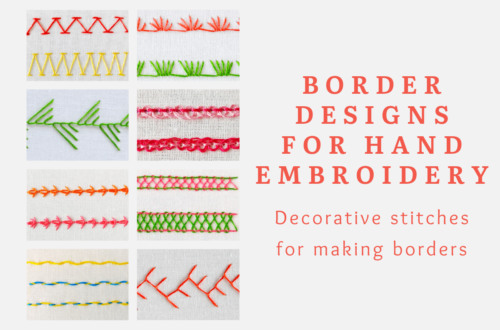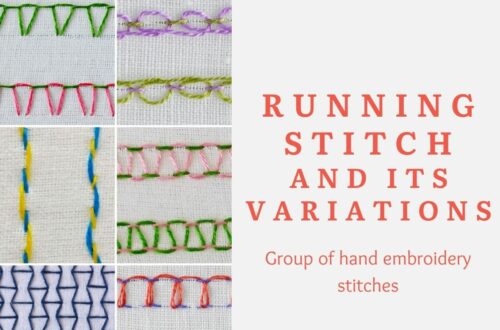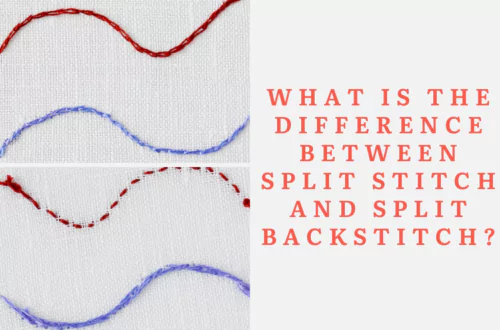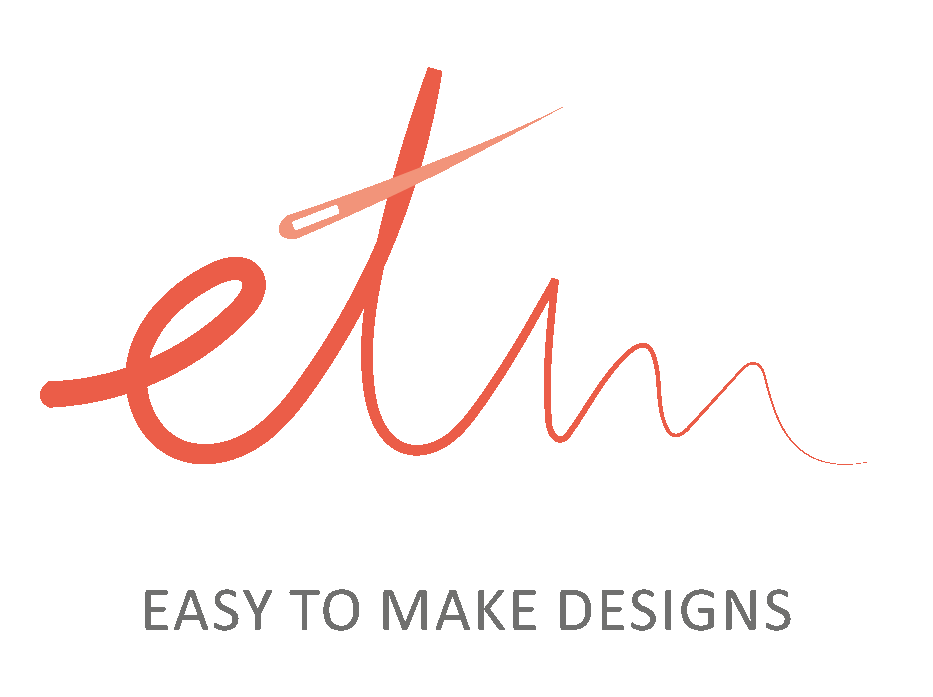
The top 10 hand embroidery stitches you should learn
There are hundreds of different hand embroidery stitches. It can look intimidating and even discouraging as you don’t have time to learn them all. The good news is that you don’t need to know all the stitches to be able to embroider. In this blog post, I will tell you about the ten essential stitches that you will need to learn to start embroidering. These ten basic hand embroidery stitches will help you start your hand embroidery journey and lay great foundations for your further learning. With those stitches, you will be capable of embroidering most of the basic patterns and even creating your original designs.
So, let’s get a needle, thread, piece of fabric, and let’s get started.
If you need some visual guidance, check out video tutorials for all the stitches here.
1. Running stitch
The running stitch or straight stitch is the basic stitch of hand embroidery. This stitch is a base of many other forms of sewing. The stitch is worked by passing the needle in and out of the fabric. The needle is always pushed through cloth starting on the side it is on and ending on the other side. Varying the length of the stitches, you can create very versatile pictures using this stitch only.
Running stitch is widely used in Sashiko, Boro, and Kantha embroidery styles as it’s perfect for mending clothes or attaching multiple layers of fabric. Quilters also use a running stitch.
2. Back stitch
The backstitch is made backward to the general direction of sewing. In embroidery, this stitch forms the lines and is most often used to outline shapes and to add fine detail to an embroidered picture. You can also use it to embroider lettering. You can work this stitch straight and curved. Stitches of different lengths will allow you to make even the smallest and most detailed curves.
3. Split stitch
The Split stitch is a perfect choice for any pattern that involves outlining. You can make filling with thick lines of this stitch. Also, this stitch is a go-to when you need outlining for satin stitches as it has a smooth surface of the line and will support a flat, clean edge for the satin stitch.
4. Stem stitch
The Stem stitch makes a rope-like line. How heavy the rope depends on the thread you use. Stem stitch can be very delicate, and you can use it on the most delicate embroidery pieces. Or it can be bold. This stitch is handy if you need to embroider curves, waves, or little circles. As the name of the stitch suggests, we use it to embroider leaves and stems of the plants. Also, stem stitch can be used to fill an area, by working rows of stem stitch close together. I like to use a stem stitch as an outline for satin stitch too.
5. Seed stitch
The Seed stitch, also called Rice stitch, is used as a filler stitch. It is a simple series of straight stitches that are even in size and evenly spaced apart but going in random directions. It can also be worked in a uniform pattern when the stitches are all aligned in the same direction.
Depending on how dense your stitches will be, you can get a very light filling, or very heavy and textural. Also, you can play with colors – mix colors and make a confetti filling or use the same color as a fabric and get a simple, but textural look.
6. Satin stitch
A Satin stitch or Damask stitch is a series of flat stitches that completely cover a section of the background fabric. It is considered a filler stitch, but you should be careful to use it only for small areas of filling, as bigger satin stitches tend to loosen up.
If you look to a more smooth satin look, keep in mind that:
- Thinner threads (or single strands) work better than more strands of thicker threads
- Ground fabric with high count and full weave will work better
- Keep it small, don’t try to fill significant areas with this stitch
- When embroidering, start satin stitch in the middle and move to the sides of the design
- For more beautiful edges, outline the satin stitch first (using a split stitch or a stem stitch)
7. Padded satin stitch
To work the Padded satin stitch, also called Raised satin stitch, you will need to outline and fill the stitch area first. For outlining, use a split stitch or a stem stitch and for the filling – seed stitch. After the filling, the work is the same as working the simple Satin stitch.
8. Chain stitch
Chain stitch is an embroidery stitch in which a series of looped stitches form a chain-like pattern. Chain stitch is an ancient craft – examples of surviving Chinese chain stitch embroidery examples date back to 5th – 3rd century BC. This simple stitch is very versatile, great for outlining, and also for filling. Chain stitch is very handy when you have to embroider flowing, curvy lines.
Did you know that you can make a chain stitch in two different ways? You can make regular and reverse chain stitch. In my video tutorial, I show you both ways. Try them and choose which one is your favorite, or use them both, as sometimes it’s convenient to switch from one method to another.
9. Blanket stitch
The blanket stitch, also called buttonhole stitch, began as a way to finish the edges of blankets and other things like tea towels and pillowcases. Now it’s used to complete an edge, attach an appliqué, or as a decorative stitch on its own. There are a lot of ways to use this stitch as a decorative stitch – from flowers and leaves to filling and outlining.
If you want to practice Blanket stitch – you can check out this FREE embroidery pattern.
10. French knots
The French knot stitch is an embroidery technique in which we knot the thread around itself in a specific way. This stitch has a reputation for being one of the most difficult, but I find it very simple, and I like to use it. Follow these simple tips, and you’ll love French knots as I do:
- Wrap the thread around the needle two times (3 times is maximum). If you need a bigger knot – use thicker yarn or more strands
- Leave a small space between the beginning of the stitch and the place where you take the needle down into the fabric, so your knot doesn’t pop to the back of the fabric
- Pull the thread slowly through the wraps to the back of the material, so the thread doesn’t knot on itself and keep the working yarn under tension until the last possible moment as it passes to the back of the fabric
- Use a milliner needle instead of an embroidery needle. It has an eye that’s the same thickness as the shaft, so it’s easy to pass the needle through the tight wraps without getting hung up on the eye.
What’s next?
Take a piece of fabric, draw some straight lines (and curved ones too), and start embroidering.
If you need some visual guidance – you can watch video tutorials for all the ten essential embroidery stitches here.
If you want to practice blanket stitch – I’ve created a beautiful Christmas tree pattern with blanket stitches. You can download it for free!
And remember to practice. “Practice makes perfect. After a long time of practicing, our work will become natural, skillful, swift, and steady” (Bruce Lee).


You May Also Like

Border designs for hand embroidery
13 May 2021
Running stitch and its variations
12 October 2021
